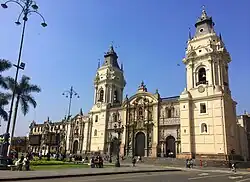Jirón Carabaya
| Jirón Augusto Wiese | |
 | |
| Part of | Damero de Pizarro |
|---|---|
| Namesake | Carabaya Province |
| From | Jirón Áncash |
| Major junctions | See list |
| To | Paseo de la República |
| Construction | |
| Completion | 1535 |
Carabaya Street (Spanish: Jirón Carabaya), formerly Augusto Wiese Street (Spanish: Jirón Augusto Wiese),[1][2] is a major street located at the Damero de Pizarro, an area of the historic centre of Lima, Peru. The street starts at its intersection with the Jirón Áncash, and ends at Paseo de la República Avenue.[3]
It runs parallel to Union Street and similarly connects the Plaza Mayor with the Plaza San Martín, ending at the Paseo de los Héroes Navales.[4]
History
In 1862, when a new urban nomenclature was adopted, the road was named jirón Carabaya, after Carabaya Province (it was later renamed during the 20th century, being named after philanthropist Augusto Wiese Eslava).[2] Prior to this renaming, each block (cuadra) had a unique name:[5]
- Block 1: Pescadería, after a fish market that was later demolished.[6][7]
- Block 2: Gradas de la Catedral/Cruz de Gradas/Covachuelas, after the steps that lead to the Cathedral.[6] Also at one point called Peligro by a foreigner.[8]
- Block 3: Bodegones/de la Requena, the former name coming from the warehouses located in the street.[6][9]
- Block 4: de Coca, after the family that lived there.[6][10]
- Block 5: Filipinas/de Doña Leonor de Ampuero/Solisvango, named after a local branch of the Royal Company of the Philippines located in the street; the latter two were due to a woman and a family who resided there, respectively.[6]
- Block 6: Divorciadas, after the divorced women that lived there in a building known as the Casa de Divorciadas.[6][11]
- Block 7: Pando, after José Antonio de Pando y Riva.[6][12]
In 1872, a large crowd took over the street, marching towards the Plaza Mayor in response to the attempted coup d'état.[13] During its history, people such as Manuel Candamo, Ramón Castilla and Augusto B. Leguía purchased properties in the street, where they subsequently lived.[14] The latter's property was looted after he was ousted in 1930, being later demolished in the 1960s.[15] Castilla's residence, known as the Casa de Castilla, was in danger of being demolished in 1976, four years after it was declared part of the Cultural heritage of Peru.[16]
Starting in the mid to late 19th century, the traditional architecture of the street became replaced in favour of French-inspired buildings.[17] Under the government of Leguía, a return to traditional architecture started to manifest, taking influences from both Spanish (Colonial Revival) and Indian (Neo-Indigenist/Neo-Peruvian) architecture.[18]
Transportation
The street's first four blocks are restricted to pedestrian use only,[19] while access to its second block is restricted to government officials or invitees in the same capacity.
Bus service
Between its fifth and sixth blocks, a station of the Metropolitano operates at the street's intersection with Cuzco Street since 2009,[20] forming part of the bus service's Route C.[21] Additionally, the service's Central Station is located under the Promenade of the Naval Heroes, which immediately follows the end of the avenue.
Train service
Desamparados station, located at the northern end of the street, operates a bi-annual service of the Ferrocarril Central Andino (FCA) during Holy Week and the National Holidays. In 2025, the announced an additional service, coinciding with the celebrations of the Battle of Junín.[22]
As of July 2025, a project for a railway connecting Lima and Chosica is underway, involving Desamparados, as well as nearby Monserrate station.[23]
See also
References
- ^ "Cercado: bomberos controlan amago de incendio en Jr. Carabaya". El Comercio. 2016-12-24.
- ^ a b Osorio 2017, p. 18.
- ^ "Lima: Así luce el paseo peatonal de los jirones Áncash y Carabaya". Perú.com. 2014-06-05.
- ^ Osorio 2017, p. 6.
- ^ Bromley 2019, p. 148.
- ^ a b c d e f g Orrego Penagos, Juan Luis (2011-07-16). "Las antiguas calles de Lima". Blog PUCP.
- ^ Bromley 2019, p. 363–364.
- ^ Bromley 2019, p. 249–250.
- ^ Bromley 2019, p. 208–209.
- ^ Bromley 2019, p. 231–234.
- ^ Bromley 2019, p. 257.
- ^ Bromley 2019, p. 336–337.
- ^ Osorio 2017, p. 34.
- ^ Osorio 2017, p. 37–40.
- ^ Osorio 2017, p. 73.
- ^ García, Miguel (2021-11-17). "La casa de Ramón Castilla estuvo a punto de ser demolida en 1976". El Comercio.
- ^ Osorio 2017, p. 40–47.
- ^ Osorio 2017, p. 69.
- ^ "MML: Conoce el plan de desvío por las nuevas obras de peatonalización del Centro Histórico de Lima". Gob.pe. 2022-01-28.
- ^ "El legendario Jirón de la Unión cumple 400 años de vida". Andina. 2009-10-06.
- ^ "Metropolitano: vándalos atacaron estación Jirón de la Unión y hoy desvían la ruta A y recortan ruta C". El Comercio. 2022-12-14.
- ^ Espinoza, Analí (2025-07-26). "Tren Lima-Huancayo partió con más de 300 pasajeros en recorrido por Fiestas Patrias: ¿Cuándo será la próxima salida?". Infobae.
- ^ Milla Loo, Wendy (2025-07-14). "Tren Lima-Chosica llegará solo hasta la Estación Desamparados en su fase inicial, dice MML: ¿cómo operará y en qué horarios?". RPP Noticias.
Bibliography
- Bromley Seminario, Juan (2019). Las viejas calles de Lima (PDF) (in Spanish). Lima: Metropolitan Municipality of Lima. Archived from the original (PDF) on 2020-04-20. Retrieved 2023-12-19.
- Osorio Gonzales, Oscar Guillermo. Pasado y presente del Jirón Carabaya (1883-1930) (PDF) (Thesis thesis). Universidad Nacional Mayor de San Marcos.